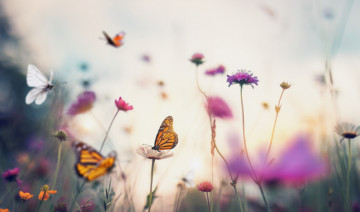
What We Can Do for Butterflies
Butterflies are stunning works of aerial art, flitting about the garden and bringing their beautiful colors, graceful wing shapes, and peaceful natures to our yards. Yet butterflies are at risk from many different hazards, and their populations are in danger. Fortunately, there are many easy things we can do to help butterflies in every yard, garden, and landscape.
How Butterflies Help Us
Butterflies are more than just pretty guests in our gardens. These insects are prolific pollinators, increasing fruit, berry, and vegetable yields and increasing blooms on all types of flowers. Many of these plants are not only edible, but also have medicinal uses that wouldn’t be possible without butterflies.
All types of butterflies are also important links in the food chain, providing sustenance for other insects, birds, bats, reptiles, and amphibians. The younger life stage of many butterflies – caterpillars – also helps with pest control, eating less desirable insects such as aphids. Overall, butterflies help improve biodiversity and are an important part of every ecosystem.
Butterflies Are at Risk
Yet butterflies are at grave risk. Overuse of pesticides kills butterflies and caterpillars, while herbicide use often kills the food and host plants butterflies rely on for survival. Habitat loss through monoculture agricultural practices, urban development, and loss of roadside wildflowers destroys the space butterflies need, while climate change alters bloom cycles and butterfly food supplies. Pollution can also destroy habitat, and wild butterflies can be contaminated by diseases and parasites introduced through butterfly releases.
Today, one in every five butterfly species found in the United States are considered endangered, and more of these beautiful fliers are endangered, threatened, or at risk all around the world.
10 Easy Things We Can Do to Help Butterflies
There are many easy steps we can take in our gardens and landscapes to make them more butterfly-friendly. No matter what the size, style, or condition of your outdoor space, you can help butterflies if you…
- Choose Butterfly-Friendly Plants – Both host plants and nectar-bearing flowers can assist butterflies in different stages of their life cycles. Milkweed is a common choice, but there are many beautiful flowers, trees, and shrubs that can nurture butterflies. Opting for native plants is best, as they will be better adapted to local conditions and more easily recognized by butterflies.
- Reduce Chemical Use – The less you use of all types of chemicals, from pesticides and herbicides to chemical fertilizers, outdoor cleansers, and more, the better the habitat will be for butterflies and all types of wildlife. Where chemicals are essential, opt for organic products whenever possible and always follow the proper application and use instructions.
- Create Butterfly Shelters – These delicate insects require cozy spaces in poor weather, and some species overwinter in appropriate shelter. A dense brush pile or woodpile with good spaces for butterflies to crawl into is ideal, or add a butterfly house with tall, narrow slits to the yard. Thick mulch and deep leaf litter is also helpful for butterflies and caterpillars.
- Make a Puddler – Butterflies visit shallow puddles to drink and absorb essential salts and minerals from damp mud and sand. Puddlers are easy to create in shallow sunny spots or small dishes that can be placed appropriately in the garden, with plenty of perches and edges for butterflies to easily access the moisture.
- Add a Butterfly Feeder – While butterflies sip nectar from many different flowers, they may also visit dedicated feeders where fermenting banana mash, crushed fruit, natural fruit juices, or even stale beer is offered. A fruit skewer is easy to hang from a tree to attract hungry butterflies, and they will even visit hummingbird feeders.
- Avoid Genetically Modified Crops – Conscientious grocery shopping can help butterflies. Genetically modified crops and GMO foods are often designed to be sprayed with hearty pesticides, making mass commercial agriculture easier. This is dramatically damaging for butterflies, however, and more responsible farming and local crops are always a better choice.
- Fight Climate Change – While climate change is a global concern, small steps at home like switching to energy efficient appliances, minimizing water and electricity use, and reducing one’s carbon footprint with less fuel use can help protect habitat and keep butterflies healthy and happy all around the world.
- Support Nature Centers – Many local nature centers will have butterfly gardens or waystations for migrating butterflies that feature the best flowers and shelter for these gorgeous insects. Visiting nature centers helps ensure these facilities receive funding, and even small donations can be helpful. Volunteering to help at the facility is another option.
- Learn More About Butterflies – Learning to identify butterfly species and what their needs are, including their life cycles and migration patterns, will help you better appreciate just how distinctive and amazing these insects can be. As you learn more, you can share your knowledge with friends, neighbors, children, and others to spread the word about butterflies.
- Enjoy Butterflies – The more you see and enjoy butterflies, the more you will grow to appreciate each one of them and will be moved to take even more steps to protect them. Your dedication to butterflies can be an inspiration to others, and the more people who take even small steps to help butterflies, the more each of these insects will benefit.
While every person may not be able to take every step, the more steps we all manage to help butterflies the better off these beautiful fliers will be and the more they will be able to help us with pollination, biodiversity, and artistic aesthetics.

